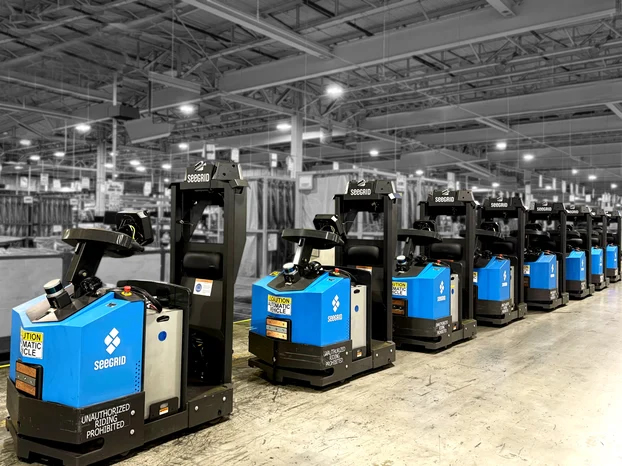Technologies like autonomous mobile robots (AMRs) and automated guided vehicles (AGVs) are helping companies bring autonomy to material movement more efficiently, safely, and cost-effectively than ever before.
Maximizing ROI with Mobile Automation: What the Data Shows
Article from | Seegrid
Introduction
As labor shortages persist and pressure mounts to improve operational efficiency, many modern industrial organizations are leaning into mobile automation to future-proof their operations.
Technologies like autonomous mobile robots (AMRs) and automated guided vehicles (AGVs)are helping companies bring autonomy to material movement more efficiently, safely, and cost-effectively than ever before. But the success of these deployments hinges on one factor: return on investment (ROI).
What ROI Really Means in Mobile Automation
When assessing ROI, most organizations start with labor cost savings—but that’s just a piece of it. Full ROI also includes improved safety, reduced product damage, lower equipment maintenance, increased throughput, enhanced operational consistency, heightened employee morale, and so much more.
Automation helps shift manual labor from high-risk and highly repetitive movements to value-added tasks—easing workforce constraints while optimizing productivity and reducing risk exposure. In some cases, it also enables inventory reductions due to improved flow and fewer bottlenecks. Every dollar invested in autonomy helps future-proof organizations and your labor force allowing continuous scalability that meets rising demands.
The Fastest Path to Payback
Across manufacturing, warehousing, and logistics, mobile automation has the potential to
consistently deliver strong ROI—often in under 18 months. So what’s the quickest way to
achieve payback? By starting with high-frequency, low-complexity tasks such as repetitive, non-conveyable material movement workflows. These often account for up to 80% of a facility’s throughput, making them ideal candidates for successful automation.
By targeting the right workflows, organizations can unlock immediate and measurable benefits:
● Lower labor costs and no concern for worker absenteeism
● Minimize risk exposure from eliminating manual touchpoints
● Increased throughput and process reliability
● Reduced damage to products, infrastructure, and equipment
● Enhanced employee morale by reallocated manual labor to more value-added tasks
The Four Key Factors that Accelerate ROI
These four factors consistently drive faster ROI for organizations adopting mobile
automation—regardless of industry, scale, or workflow complexity.
1. Fit-for-purpose technology:
Mobile automation platforms that offer robust perception, adaptive autonomy, and strong
localization capabilities tend to perform more reliably in real-world environments—especially when navigating shared spaces with people and equipment.
2. Quick, low-friction deployment:
Fast, effective deployment depends as much on experience as it does on technology. Solutions that require minimal infrastructure changes and are backed by experienced teams with extensive real-world deployments have the ability to implement more quickly and scale confidently, accelerating your return on investment.
3. Tailored applications:
Maximizing ROI starts with matching the right autonomous solution to the right application.
Different automation technologies excel at different tasks, so success—and ROI—depends on choosing the right approach for each workflow and building it out intentionally.
4. Operator adoption:
Even the best technology falls short without user buy-in. Engaging frontline employees early and providing educational training is critical to foster a smooth adoption and long-term automation success.

Lessons from the Field
Organizations that succeed with mobile automation tend to follow a few shared principles:
● Define clear goals: Whether it’s reducing manual touches, increasing throughput, or
improving safety, having a focused objective helps align teams and measure progress.
● Start with a win: Start simple. Begin with well-understood, lower-complexity workflows
before expanding to broader or more dynamic tasks.
● Integrate with existing systems: Tightly linking mobile automation with WMS, ERP, or
MES platforms enables better coordination, visibility, and decision-making.
● Scale with intention: Build on success. Use early deployments to refine processes, win
internal support, and strategically expand over time.
Beyond Deployment: Sustaining ROI
ROI isn’t static, and when mobile automation is treated as a long-term operational strategy, it will continue to grow exponentially. Ongoing data analysis, route optimization, and vendor support can further improve performance and adaptability as individual facility needs evolve. A focus on safety, sustainability, and flexibility is necessary for the long-term value of automation—keeping operations competitive while minimizing risk.
Mobile automation isn't a one-time investment—it's a long-term strategy for unlocking operational ROI.
Organizations that treat automation as an evolving part of their overall operations and business objectives, rather than a standalone project, see the greatest returns. With the right foundation—fit-for-purpose technology, experienced deployment, aligned applications, and operator engagement—mobile automation delivers undeniable lasting value. Start strong, scale strategically, and keep optimizing to maximize your ROI over time.
The content & opinions in this article are the author’s and do not necessarily represent the views of ManufacturingTomorrow
Comments (0)
This post does not have any comments. Be the first to leave a comment below.
Featured Product

